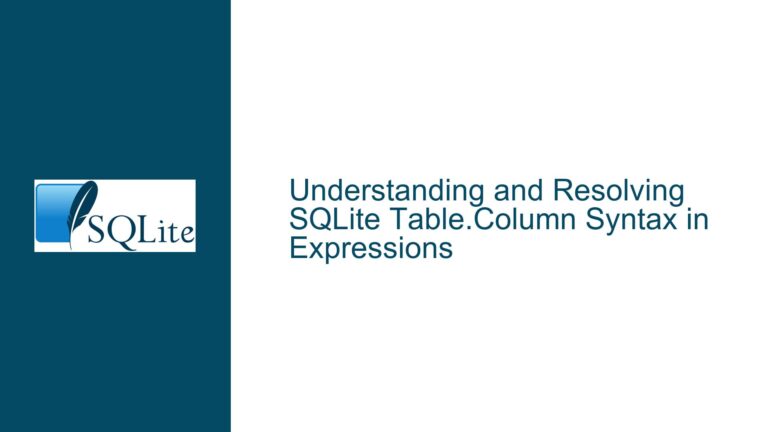Heap Buffer Overflow in SQLite Due to Foreign Key Column Mismatch
Issue Overview: Heap Buffer Overflow Triggered by Foreign Key Column Mismatch
The core issue revolves around a heap buffer overflow that occurs in SQLite when executing a specific query involving a foreign key constraint. The query in question creates a table v0 with a foreign key that references a non-existent table t0. The foreign key is defined with an excessive number of columns, all pointing to the same column v1. This mismatch between the number of columns in the foreign key and the underlying table leads to a heap buffer overflow, as the SQLite virtual machine fails to allocate sufficient registers to handle the foreign key columns.
The heap buffer overflow is detected by AddressSanitizer (ASAN), which reports a read of size 2 at an address just beyond the allocated memory region. The overflow occurs in the sqlite3VdbeExec function, specifically at line 89413 in the SQLite source code. The ASAN output provides a detailed stack trace, indicating that the issue arises during the execution of the PRAGMA foreign_key_check command. Additionally, running a debug version of SQLite reveals an assertion failure in the sqlite3VdbeExec function, further confirming the problem.
The bug has been present in the SQLite source code for several years, with bisect results indicating that it dates back to at least SQLite 3.8.1, released on 2013-10-17. The issue was finally identified and fixed in the latest commit on the SQLite trunk. The root cause of the problem lies in the code generator’s failure to allocate enough registers in the virtual machine when handling foreign keys with more columns than the underlying table.
Possible Causes: Insufficient Register Allocation and Foreign Key Mismatch
The primary cause of the heap buffer overflow is the mismatch between the number of columns specified in the foreign key constraint and the actual number of columns in the referenced table. In the provided query, the foreign key is defined with 13 columns, all referencing the same column v1 in the non-existent table t0. This excessive number of columns in the foreign key constraint causes the SQLite virtual machine to allocate insufficient registers, leading to a buffer overflow when the PRAGMA foreign_key_check command is executed.
The issue is exacerbated by the fact that the code responsible for generating the virtual machine instructions for foreign key checks does not account for the possibility of a foreign key having more columns than the referenced table. This oversight in the code generator results in an incorrect allocation of registers, which in turn leads to the heap buffer overflow. The problem is further compounded by the fact that the assertion checks in the debug version of SQLite do not catch this issue until after the buffer overflow has already occurred.
Another contributing factor is the lack of proper validation when defining foreign key constraints. SQLite does not enforce a limit on the number of columns that can be included in a foreign key, nor does it validate that the number of columns in the foreign key matches the number of columns in the referenced table. This lack of validation allows for the creation of invalid foreign key constraints, which can lead to unexpected behavior and potential security vulnerabilities.
The issue is also related to the way SQLite handles memory allocation for virtual machine registers. When executing a query, SQLite allocates a fixed amount of memory for the virtual machine registers based on the number of columns in the query. However, in the case of the provided query, the number of columns in the foreign key constraint exceeds the allocated memory, leading to a buffer overflow. This highlights a potential weakness in SQLite’s memory management system, particularly when dealing with complex queries involving foreign keys.
Troubleshooting Steps, Solutions & Fixes: Debugging, Code Review, and Best Practices
To address the heap buffer overflow issue, several troubleshooting steps and solutions can be implemented. The first step is to ensure that the SQLite source code is compiled with the -DSQLITE_DEBUG flag. This flag enables additional assertion checks in the code, which can help identify issues before they lead to buffer overflows or other memory-related problems. As noted in the discussion, enabling this flag can significantly improve the detection rate of bugs during fuzzing and other testing activities.
Once the debug version of SQLite is compiled, the next step is to run the problematic query and analyze the assertion failure. The assertion failure in the sqlite3VdbeExec function provides valuable information about the root cause of the issue. Specifically, the assertion pOp->p3>0 && pOp->p3<=(p->nMem+1 - p->nCursor) indicates that the virtual machine is attempting to access a register that is out of bounds. This information can be used to trace the issue back to the code generator and identify the specific point where the register allocation fails.
After identifying the root cause, the next step is to review the code responsible for generating virtual machine instructions for foreign key checks. This code should be modified to ensure that it correctly allocates registers for all columns in the foreign key constraint, even if the number of columns exceeds the number of columns in the referenced table. Additionally, the code should include validation checks to ensure that the number of columns in the foreign key matches the number of columns in the referenced table. This validation should be performed at the time the foreign key constraint is defined, rather than waiting until the PRAGMA foreign_key_check command is executed.
In addition to modifying the code, it is important to update the SQLite documentation to reflect the limitations and best practices for defining foreign key constraints. The documentation should clearly state that the number of columns in a foreign key must match the number of columns in the referenced table, and that exceeding this limit can lead to undefined behavior. This information should be included in the section of the documentation that covers foreign key constraints, as well as in any tutorials or examples that demonstrate the use of foreign keys.
Finally, it is recommended to conduct a thorough code review of the entire SQLite codebase to identify any other potential issues related to memory allocation and foreign key handling. This review should focus on areas of the code that deal with complex queries, particularly those involving multiple tables and foreign key constraints. Any issues identified during this review should be addressed promptly, and the fixes should be included in future releases of SQLite.
In conclusion, the heap buffer overflow issue in SQLite is a serious problem that can lead to memory corruption and potential security vulnerabilities. However, by following the troubleshooting steps and solutions outlined above, it is possible to identify and fix the root cause of the issue, as well as prevent similar issues from occurring in the future. By ensuring that the SQLite code is compiled with the -DSQLITE_DEBUG flag, reviewing and modifying the code responsible for foreign key handling, updating the documentation, and conducting a thorough code review, developers can help ensure that SQLite remains a reliable and secure database solution.






